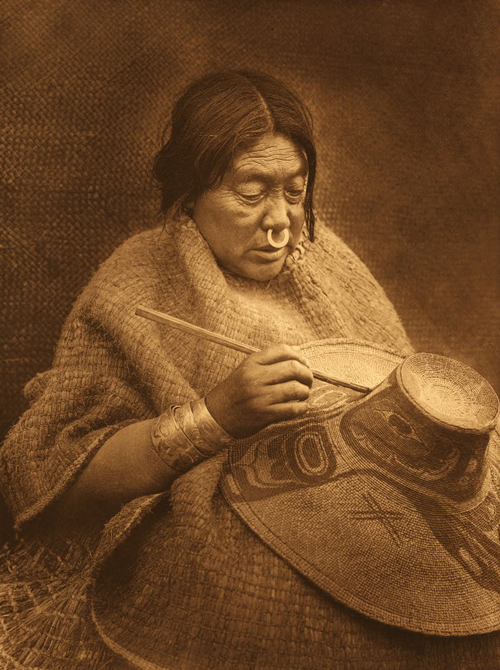At Station Camp near the mouth of the Columbia, some Clatsops and Lower Chehalis visit. Additionally, the wife of Chinook chief Delashelwilt brings six young females to camp. Clark describes Chinookan head flattening and woven mats and hats.
Where to Put Winter Camp
by Yellowstone Public Radio[1]Originally aired weekdays by Yellowstone Public Radio during the Bicentennial observance of 2003-2006. Narrated by Hal Hansen. Scripts by Whit Hansen and Ed Jacobson. Produced by Leni Holliman. © … Continue reading
Painting a hat – Nakoaktok (1915)
Edward S. Curtis (1868–1952)
The North American Indian volume 10, plate 329.
Sacagawea’s Blue Coat
we gave the Squar a Coate of Blue Cloth for the belt of Blue Beeds we gave for the Sea otter Skins purchased of an Indian.
—William Clark
Clatsop and Lower Chehalis Visitors
Several Indians Visit us to day of different nations or Bands Some of the Chiltz [Lower Chehalis] Nation who reside on the Sea Coast near Point Lewis, Several of the Clotsops [Clatsops] who reside on the opposit Side of the Columbia imediately opposit to us, and a Chief from the Grand rapid to whome we gave a Medal.
—William Clark
Six Young Women
An old woman & wife to a Cheif of the Chinnooks [Chinooks] came and made a Camp near ours She brought with her 6 young Squars I believe for the purpose of gratifying the passions of the men of our party
—William Clark
Chinookan Indian Women
the womin of the Chinnook Nation have handsom faces low and badly made with large legs & thighs which are generally Swelled from a Stopage of the circulation in the feet (which are Small) by maney Strands of Beeds or curious Strings which are drawn tight around the leg above the anckle, their leges are also picked with different figures . . . . all those are Considered by the natives of this quarter as handsom deckerations
—William Clark
Flattened Heads
The Men are low homely and badly made, Small Crooked legs large feet, and all of both Sects have flattened heads— The food of this nation is principally fish & roots the fish
—William Clark
Woven Mats and Hats
We purchased Cramberies Mats verry netely made of flags and rushes, Some roots, Salmon and I purchased a hat made of Splits & Strong grass, which is made in the fashion which was common in the U States two years ago also Small baskets to hold Water made of Split and Straw
—William Clark
Weather Diary
Day of the month Wind State of the Weather 21st S E clouday after rain rained all last night untill 1 P. M and Cleared away and was Cloudy without rain
—Meriwether Lewis[2]Some abbreviations have been spelled out.
Middle Village-Station Camp is a High Potential Historic Site along the Lewis and Clark National Historic Trail managed by the U.S. National Park Service. The site provides interpretation and is part of the Lewis and Clark National and State Historical Parks.
Notes
| ↑1 | Originally aired weekdays by Yellowstone Public Radio during the Bicentennial observance of 2003-2006. Narrated by Hal Hansen. Scripts by Whit Hansen and Ed Jacobson. Produced by Leni Holliman. © 2003 by Yellowstone Public Radio. |
|---|---|
| ↑2 | Some abbreviations have been spelled out. |
Experience the Lewis and Clark Trail
The Lewis and Clark Trail Experience—our sister site at lewisandclark.travel—connects the world to people and places on the Lewis and Clark Trail.
Discover More
- The Lewis and Clark Expedition: Day by Day by Gary E. Moulton (University of Nebraska Press, 2018). The story in prose, 14 May 1804–23 September 1806.
- The Lewis and Clark Journals: An American Epic of Discovery (abridged) by Gary E. Moulton (University of Nebraska Press, 2003). Selected journal excerpts, 14 May 1804–23 September 1806.
- The Lewis and Clark Journals. by Gary E. Moulton (University of Nebraska Press, 1983–2001). The complete story in 13 volumes.




